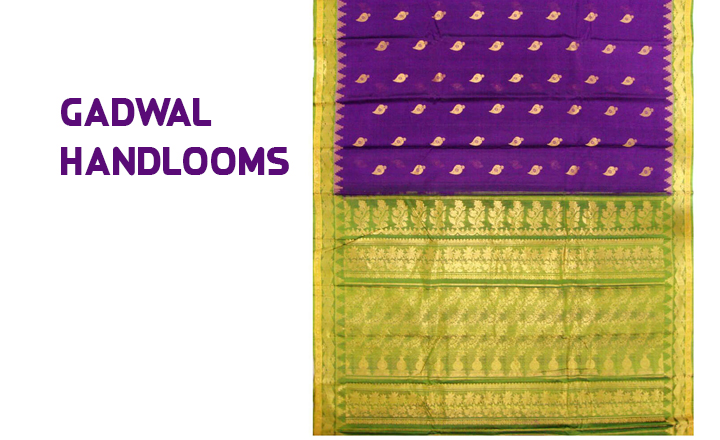Weaving Traditions of a Heritage Town!

We have always admired handlooms that are rich and elegant. In fact, buying handlooms and wearing them is ingrained in our ethos from our ancestors. Despite the onslaught of modernity and western trends, still the Indian values and taste within us, makes us look for handlooms, which give a wonderful ethnic flavour. Gadwal, in the state of Telangana is considered world famous for the handloom zari as well as cotton sarees.
Gadwal Sarees are highly popular for many decades. The historic town is known for its characteristic cotton sarees that come with an attached silk border as well as silk pallu. The local weavers are highly skilled wherein more than 5 meters of saree fabric could be folded to fit into something as small a match box. The materials used in manufacturing Gadwal handloom sarees are Silk / Cotton and Zari. The silk border is made of Tussar or mulberry and the body is made using unbleached cotton. Weavers also make pure silk models of Gadwal sarees.
Gadwal handlooms are quite popular for the durability of the various colours that are used in the yarn. The mixture of these colours gives the durability. The count used in weaving technique results in the softness as well as the hardness of the fabric. The speciality of each and every thread used in Gadwal saree is that it is hand woven. For each saree, about 4-8 days of effort by two weavers is required.
The process of making a Gadwal Saree starts with the process of dyeing silk or cotton yarn. Dyeing is a colouring process achieved by dipping the yarns in boiled color water at a very high temperature. The colours are applied based on the specification by weavers and orders from customers. After drying the yarn in shade, it is then rolled over small sticks and finally converted to thread. The yarn is now loaded as warp into the loom for the actual process of weaving. There are handloom societies in the town, that market these sarees, to ensure remunerative prices for the weavers. Gadwal is proudly represented in various handloom expos held regularly all over India.
Gadwal Sarees are woven traditionally according to the interlocked-weft technique (Kuppadam or Tippadam) or Kotakomma (also called as Kumbam) in terms of the border designs. Hence these are also known as Kotakomma or Kumbam sarees. Clearly, this town which was the capital of a local province during the era of dynasties with an impressive heritage and history also finds it name prominently among the handloom traditions of India.
Etikoppaka village is known for its lac industry, and this has resulted in an exclusive tradition of making attractive toys. The lac resin is obtained from the secretions of numerous lac insects and is used for many purposes, including toys and crafts.
The wild lac is collected by the rural people from the forests of Eastern Ghats close by and clear lac is extracted from the raw material wherein the crushed lac sticks are tied within a thin cloth. The contents are then dipped in hot water. After blending the clarified lac obtained is oxidized with other naturally extracted dyes. It is now readily applied to the finely carved wooden articles. The vegetable dyes which are readily prepared are further mixed to this lac, during oxidation process. The product obtained as a result is rich and colored lacquer which is used to decorate the Etikoppaka toys, and exported to toy collectors and art galleries all over. The wood used to make these toys is soft in nature and hence, the art of toy making is also called as Turned wood Lacquer craft.
A wonderful range of attractive colors such as olive green, ochre, turquoise and indigo blue are used too. When the lacquer is clearly processed with these blends, the wooden artefacts get an exquisite luster. The artefacts of Etikoppaka which are finely painted with oxidized lacquer, are also given a final furnish using a mogali reku (kevda leaf) making them quite charming. The wide, attractive range of colors and subdued elegance makes these lac toys quite adorable. The artisans also create table lamps, candle sticks, mobile holders, curtain rods, ear rings, pens, pen stands, key chains, bangles, and other decorative items.